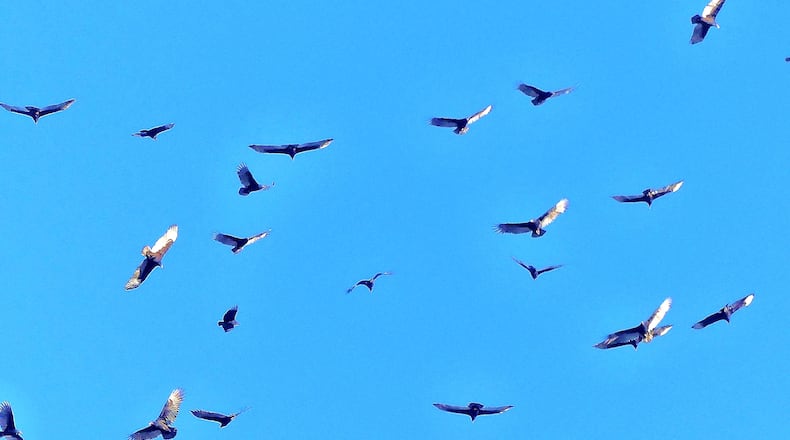I was walking down a street in Vidalia in South Georgia the other day when I turned a corner and almost bumped into a middle-aged man standing there. He was looking up, taking pictures with his cellphone of something in the sky.
So, I looked up, and saw an amazing sight — one of the largest kettles of vultures I’ve ever seen. There were hundreds of them, black vultures and turkey vultures (Georgia’s two vulture species), wheeling, soaring and gliding overhead. The silver gray flight feathers of the turkey vultures glistened in the afternoon sun, an impressive sight.
“Quite a kettle, huh?” the man asked.
I agreed. Then he told me that one street over, I could also see a “committee” of vultures. What? I asked. He explained that a large flock of vultures spiraling upward in flight on thermal updrafts is called a kettle because it resembles a pot of boiling water. A “committee” of vultures refers to the birds resting on the ground, in trees or on structures. “Wake” is reserved for a group of vultures that is feeding.
I walked over to the next street and, sure enough, there was a huge “committee” of vultures perched on a tall communication tower in the midst of downtown Vidalia.
The kettle obviously was migrating vultures from up North flying south to join year-round resident vultures in Georgia, Florida and other locales for the winter.
A prime destination in Georgia for migratory vultures is Reed Bingham State Park near Adel in southwest Georgia. Home to a few hundred year-round resident vultures, its vulture population soars into the thousands when the birds from up North arrive. A park worker told me earlier this week that migrating vultures are indeed arriving there now.
Vultures perform immense benefits by removing carrion from the landscape, but they also can be a nuisance — such as when they tear away window caulking or remove rubber seals and rip up windshield wipers from vehicles.
IN THE SKY: From David Dundee, Tellus Science Museum astronomer: The moon will be first quarter on Sunday. Mercury is low in the east just before sunrise. Venus is low in the east and rises about an hour before sunrise. Mars rises in the east just before dark and will appear near the moon Wednesday night. Jupiter and Saturn are low in the southwest after dark.
About the Author
Keep Reading
The Latest
Featured


